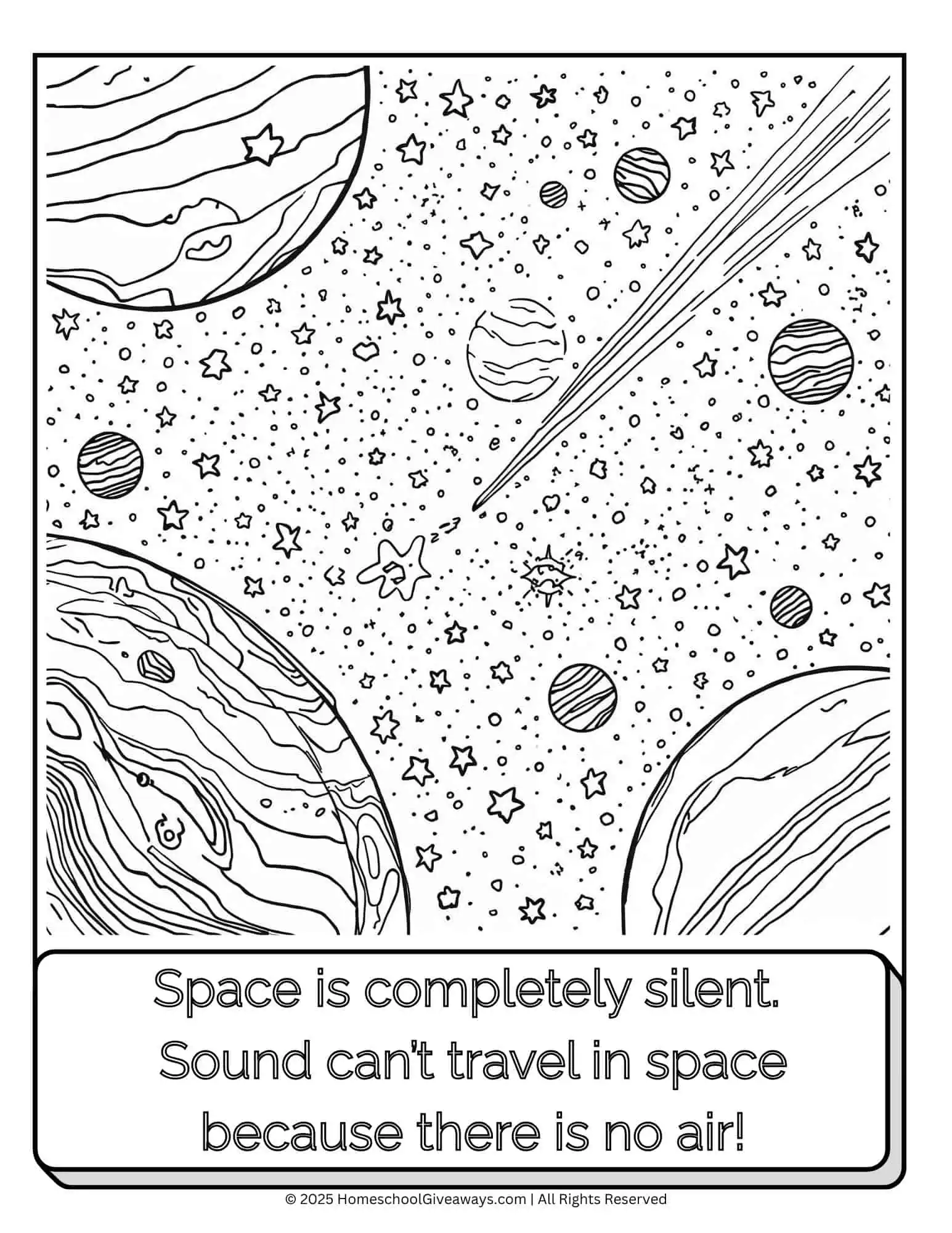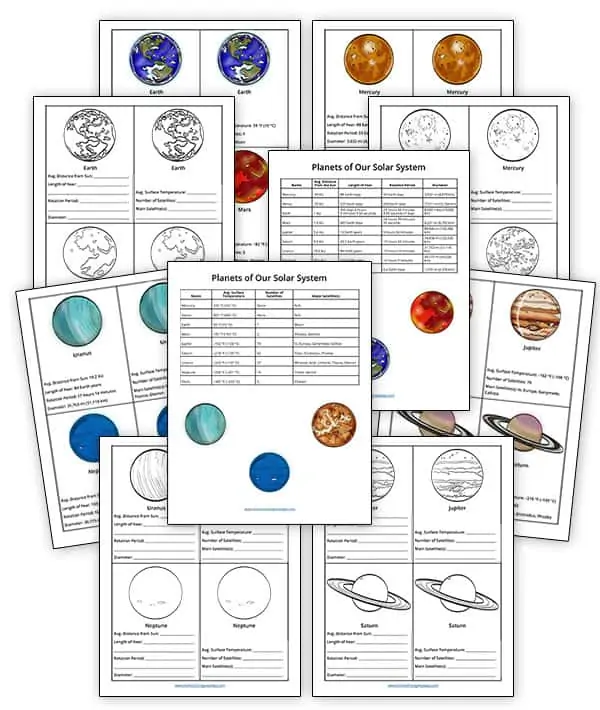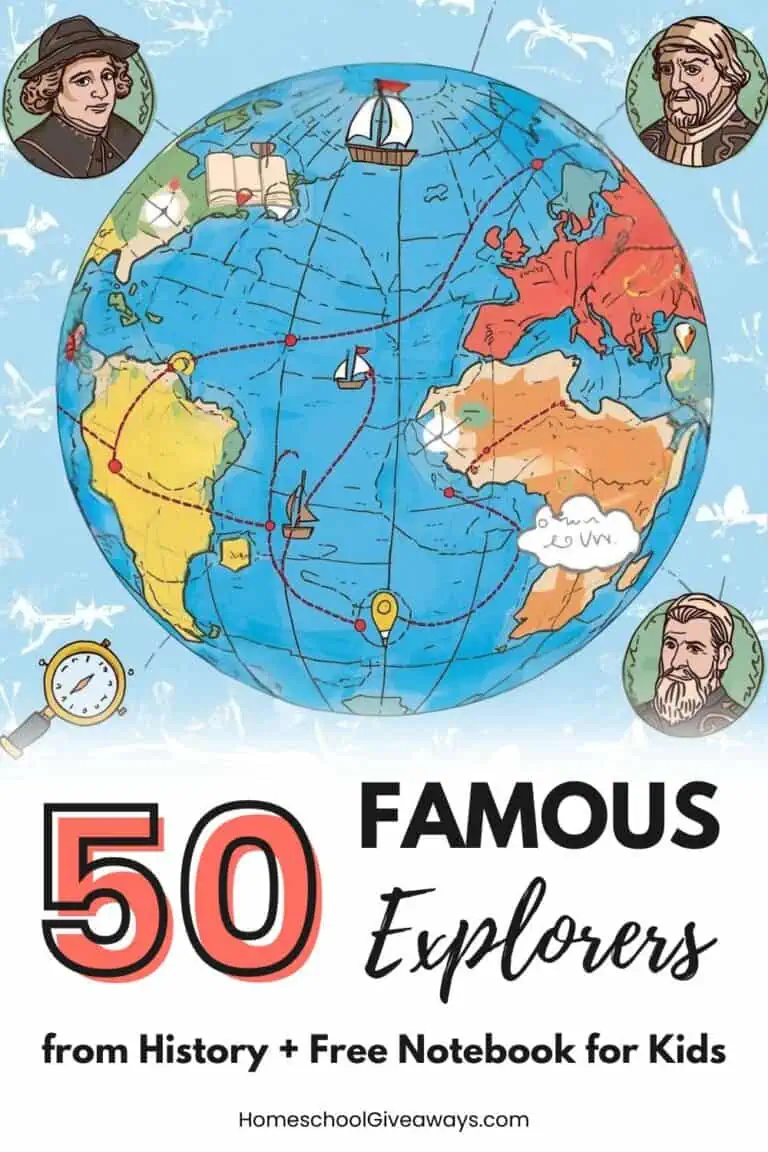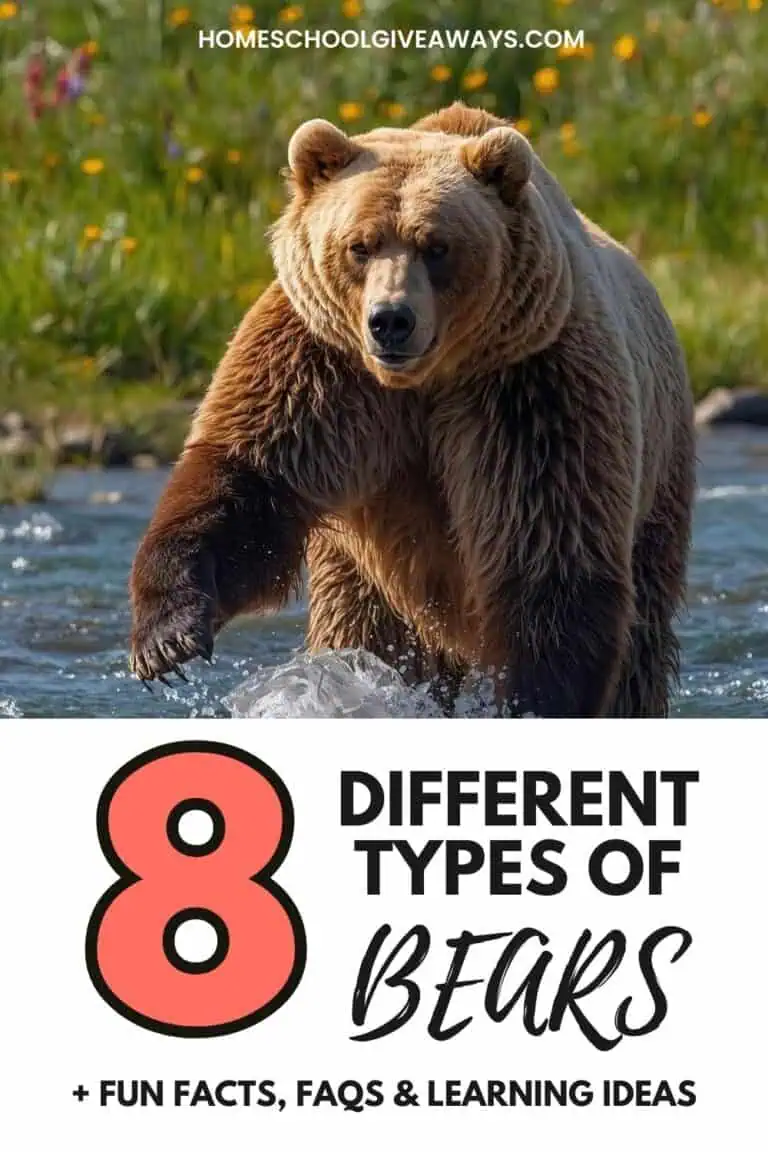25 Fun Facts About Space + Free Learning Activities for Kids
Published:
October 2, 2025

Contributor:
Charis King
Disclosure: This post may contain affiliate links, meaning if you decide to make a purchase via my links, I may earn a commission at no additional cost to you. See my disclosure for more info.
Discover fun facts about space while bringing your homeschool lessons to life. Study the universe during World Space Week or any time of year! You’ll find over 25 amazing facts, coloring pages, planet fact cards, a planets crossword, and hands-on activities to make learning exciting. From Laika the space dog to the International Space Station, and from the asteroid belt to the Andromeda Galaxy, there’s plenty to explore and enjoy.
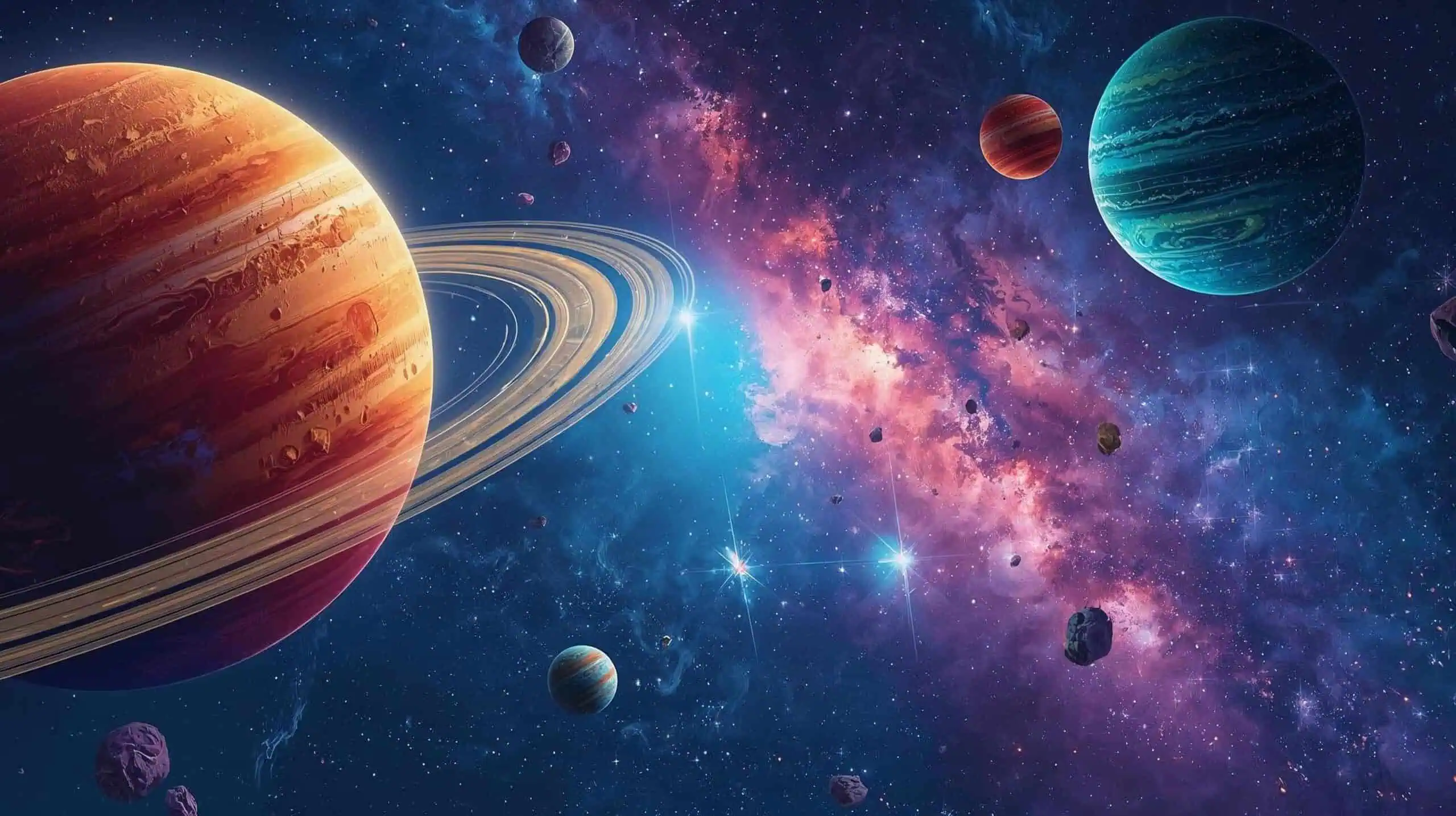
What Is Space?
When you say “space,” it’s easy to picture astronauts floating, rockets blasting off, or distant stars twinkling in the night sky. Scientifically, outer space is the vast region beyond Earth’s atmosphere. It may look empty, but it’s full of stars, planets, moons, asteroids, comets, and invisible mysteries like dark matter.
Exploring space often starts with a few key astronomy terms – simple ideas that open up a whole universe of understanding.
Key Astronomy Terms
- Astronomical Unit (AU) is the average distance from Earth to the Sun, about 93 million miles. Astronomers use it like a measuring stick for the solar system, helping put planetary distances in perspective.
Fun fact: the Sun is only one AU away from Earth, but Jupiter is about five AU away. - Light Year is a measure of distance, not time. One light year equals how far light travels in a year, roughly 6 trillion miles. That makes even nearby stars incredibly far away.
- Black Holes are regions of space where gravity is so strong that nothing, not even light, can escape.
Fun fact: the first-ever image of a black hole in 2019 showed a glowing orange ring around an invisible center, proving even invisible objects can leave a mark. - Neutron Stars are the remnants of massive stars after a supernova explosion. They are incredibly dense. In fact, just a teaspoon of neutron star material would weigh a billion tons on Earth!
- Solar Wind is a stream of charged particles constantly flowing from the Sun. It interacts with Earth’s magnetic field, producing auroras, the colorful northern and southern lights that dance across polar skies.
- Kuiper Belt and Oort Cloud are regions of icy objects at the edges of the solar system. The Kuiper Belt is home to Pluto and other dwarf planets. The Oort Cloud lies even farther out and is thought to be the source of many comets. Fun fact: the Oort Cloud is so distant that Voyager spacecrafts launched by NASA in 1977 have not yet reached it.
Space History Highlights
Space exploration is full of firsts that capture the imagination and show how human curiosity can reach beyond Earth.
First Satellite in Space: Sputnik 1 – October 4, 1957
The Soviet Union launched the first artificial satellite, Sputnik 1, on October 4 – the event that inspired World Space Week. Its simple beeping signal could be picked up on Earth, alerting the world that humans had reached space. This moment marked the beginning of the Space Race, inspiring nations to explore, innovate, and compete in space technology.
Fun fact: Sputnik 1 was about the size of a beach ball and beeped radio signals that could be picked up on Earth.
First Living Creature in Orbit: Laika the Space Dog – November 3, 1957
Just a month after Sputnik 1, Laika became the first living creature to orbit Earth aboard Sputnik 2. Scientists wanted to see if a living being could survive the conditions of space. Sadly, Laika did not survive the mission, but her journey paved the way for human spaceflight.
Fun fact: Laika’s tiny spacecraft was only about the size of a large suitcase.
First Human in Space: Yuri Gagarin – April 12, 1961
Yuri Gagarin, a Soviet cosmonaut, became the first human to orbit Earth aboard Vostok 1. He completed a single orbit in about 108 minutes.
Fun fact: Gagarin reportedly said, “I see Earth! It is so beautiful!”
First American in Space: Alan Shepard – May 5, 1961
Just a few weeks later, Alan Shepard became the first American in space with a 15-minute suborbital flight aboard Freedom 7. The mission was short, but it proved that humans could survive spaceflight and re-enter Earth safely. His successful journey was a turning point for U.S. space exploration.
First Humans on the Moon: Neil Armstrong and Buzz Aldrin – July 20, 1969
Neil Armstrong stepped onto the lunar surface during Apollo 11, followed shortly by Buzz Aldrin. Armstrong said, “That’s one small step for man, one giant leap for mankind.” Their footprints are still on the Moon today.
Fun fact: The astronauts carried a small silicon disc with greetings from world leaders, meant to represent humanity’s collective curiosity and peace.
International Space Station: First Module Launched – November 20, 1998
The first piece of the International Space Station went into orbit. Astronauts from multiple countries live and work there, conducting experiments in microgravity.
Fun fact: You can sometimes spot the ISS from your backyard as it crosses the sky like a bright moving star.
Fun Facts about Space: Planets and Phenomena
The planets of our solar system are some of the most fascinating neighbors you can study. Each one has unique features that make it stand out. For years, schoolchildren learned there were nine planets, but in 2006 Pluto was reclassified as a dwarf planet. That means we now officially count eight planets, but Pluto still holds a special place in many hearts.
Mercury: The Closest Planet
Mercury is closest to the Sun and also the smallest planet. Its surface temperature swings wildly, from hundreds of degrees during the day to far below freezing at night because it has almost no atmosphere to trap heat. Check out this video for kids about Mercury.
Fun fact: A year on Mercury is just 88 Earth days.
Venus: The Hottest Planet
Venus may not be the closest to the Sun, but it is the hottest planet in the solar system because its thick atmosphere is full of carbon dioxide. This traps heat in a runaway greenhouse effect.
Fun fact: Venus rotates backwards compared to most planets, so the Sun rises in the west and sets in the east.
Earth: The Only Planet with Life
Earth is the only planet known to support life. About 70 percent of Earth’s surface is covered in water, which is why our planet looks blue from space.
Fun fact: Earth’s rotation is gradually slowing down, which means very slowly, our days are getting longer.
Mars: The Red Planet
Mars gets its red color from iron oxide, or rust, covering its surface. It also has dust storms so massive they can cover the entire planet.
Fun fact: The tallest volcano in the solar system call Olympus Mons is on Mars. In fact, Olympus Mons is about 3 times the height of Mount Everest and is so tall that if you were standing at its base, even looking straight up, the peak would be too far away for your eye to see it.
Jupiter: The Largest Planet
Jupiter is a giant planet made mostly of gas – hydrogen and helium – which is why it’s called a gas giant. It is famous for its swirling clouds and its Great Red Spot, a storm larger than Earth that has been raging for centuries.
Fun fact: Jupiter’s moon Io has hundreds of active volcanoes, making it the most volcanically active object in the solar system. Some eruptions shoot lava higher than Mount Everest.
Saturn: The Ringed Beauty
Saturn’s rings are one of the most spectacular sights in the solar system. They are made of billions of icy particles, ranging from grains the size of sand to chunks as large as mountains. In fact the rings are so wide from the innermost to the outermost edge that their span is about the same as the distance from Earth to the Moon!
Fun fact: Saturn would float if you could place it in a giant bathtub because it is less dense than water.
Uranus: The Tilted Planet
Uranus is the coldest planet in the solar system, with temperatures dropping to -371°F (-224°C). Unlike the other giant planets, it gives off almost no extra heat from inside, which makes it especially chilly. Uranus is also tipped on its side by more than 90 degrees, so it rolls around the Sun like a ball. This extreme tilt causes wild seasons, with each pole getting 42 years of sunlight followed by 42 years of darkness.
Fun fact: Uranus was the first planet discovered with a telescope, in 1781.
Neptune: The Windy Planet
Neptune is known for its intense blue color and incredibly strong winds, which can reach up to 1,200 miles per hour. That makes it the windiest planet in our solar system.
Fun fact: Neptune was discovered through math before it was ever seen through a telescope. Astronomers noticed irregularities in Uranus’s orbit and predicted there must be another planet nearby.
Pluto: The Beloved Dwarf Planet
Pluto was reclassified in 2006, but it remains one of the most talked-about objects in the Kuiper Belt. It has mountains made of ice and even shows signs of possible underground oceans. Many still call it the ninth planet out of nostalgia.
Fun fact: When Pluto was reclassified, some schoolchildren sent letters to NASA asking them to “bring Pluto back.”
How to Remember the Planets in Order
A fun way is to use a mnemonic device – a phrase where each word starts with the same letter as a planet, from Mercury to Neptune. For example:
“My Very Educated Mother Just Served Us Noodles”
You can also make it interactive! Try the Planet Order Mnemonics lift-the-flap activity at TPT for early learners, where kids can write a fact about each planet under its flap.
Beyond the Planets
Asteroid Belt
Between Mars and Jupiter lies a band filled with rocky objects of all sizes. While sometimes imagined as packed with tumbling rocks, the asteroid belt is mostly empty space with millions of objects spread far apart.
Fun fact: The dwarf planet Ceres, found in the asteroid belt, makes up about a third of the belt’s total mass.
Comets
These icy travelers develop glowing tails when they approach the Sun. The tail always points away from the Sun, thanks to the solar wind.
Fun fact: Halley’s Comet, the most famous of all, is visible from Earth about every 76 years.
Kuiper Belt and Oort Cloud
Beyond Neptune lies the Kuiper Belt, home to Pluto and other icy worlds. Farther still, the Oort Cloud surrounds the solar system with trillions of icy objects.
Fun fact: Some of the comets you see in the night sky may have started their journey from the Kuiper Belt or Oort Cloud.
Andromeda Galaxy
The nearest large galaxy to the Milky Way. It is on a slow-motion collision course with our galaxy, expected to merge in the far future.
Fun fact: Even though Andromeda is 2.5 million light years away, you can sometimes see it with the naked eye from a dark sky.
Gamma-Ray Bursts and Supernova Explosions
These are some of the most powerful events in the universe. A supernova is the explosive death of a star, which can outshine an entire galaxy for a short time. Gamma-ray bursts release enormous energy in seconds.
Fun fact: A single supernova can release more energy than the Sun will in its entire lifetime.
Space FAQs
Is there gravity in space?
Yes – gravity is everywhere in space. It’s what keeps planets in orbit around the Sun, moons around planets, and even keeps the International Space Station circling Earth. Astronauts feel weightless because they are in free fall: both they and the spacecraft are falling toward Earth at the same rate, creating the floating sensation.
Fun fact: Even while floating inside the ISS, astronauts are still pulled toward Earth – they just keep moving fast enough sideways to keep missing it.
Is space cold?
Outer space has no air to carry heat, so it doesn’t have a temperature the way we experience it on Earth. Objects in direct sunlight can become extremely hot, while shaded areas can become freezing cold. Spacesuits and spacecraft carefully control temperature to keep astronauts safe.
Fun fact: The Moon’s surface can swing from about 260 degrees Fahrenheit in sunlight to minus 280 degrees Fahrenheit in shadow.
Are stars planets?
No, stars and planets are very different! Stars, like our Sun, produce their own light and energy through nuclear fusion. Planets do not create light-they orbit stars and reflect their light.
Fun fact: Some of the brightest points you see in the night sky are stars, not planets, but a few planets, like Venus and Jupiter, can shine so brightly they look like stars!
How many planets have rings?
Most people think only Saturn has rings, but actually four planets in our solar system have them: Jupiter, Saturn, Uranus, and Neptune. Saturn’s rings were first observed by Galileo in 1610 and are bright and easy to see, made of billions of icy particles ranging from grains of sand to chunks as big as mountains. Jupiter’s rings were discovered in 1979 by the Voyager 1 spacecraft. Uranus’ narrow, dark rings were found in 1977, and Neptune’s faint rings with clumpy arcs were confirmed in the 1980s.
Fun fact: Jupiter, Uranus, and Neptune’s rings are faint and mostly dust, so they look very different from Saturn’s spectacular display.
How many astronauts have died in space?
Space travel is risky, and sadly, some astronauts have died during missions. Most deaths occurred during takeoff or re-entry including:
- Apollo 1 (1967): 3 astronauts died in a cabin fire during a pre-flight test.
- Challenger (1986): 7 astronauts died when the shuttle broke apart shortly after launch.
- Columbia (2003): 7 astronauts died when the shuttle disintegrated during re-entry
Fun fact: Over 500 people have safely traveled into space since 1961, and every mission builds on lessons learned from past accidents.
Is the Great Wall of China visible from space?
Not easily. Contrary to popular belief, the Great Wall is very difficult to see with the naked eye from low Earth orbit. It blends into the surrounding landscape and is narrower than most people think.
Fun fact: You can more easily spot airports, roads, and cities from space than the Great Wall.
How do astronauts eat or sleep in space?
They strap themselves into sleeping bags so they don’t float away. Food comes in packets, sometimes freeze-dried, and they drink liquids from pouches with straws.
Print & Go: Free Space Coloring Pages, Fact Cards & Crossword Puzzle
Ready to dive even deeper into space fun? We’ve got free activities for you! You can color our space coloring pages, learning about planets with our fact cads & cheat sheets, and even test your knowledge with a planets crossword. Once you’ve explored all these fun activities, be sure check out our Springboard Learning Ideas for even more fun ways to discover the wonders of the solar system.
Here’s a fun fact you can explore while you color: space is completely silent! That’s because sound can’t travel without air. Grab your crayons and bring the stars, planets, and rockets on this page to life while you learn about the wonders of outer space.
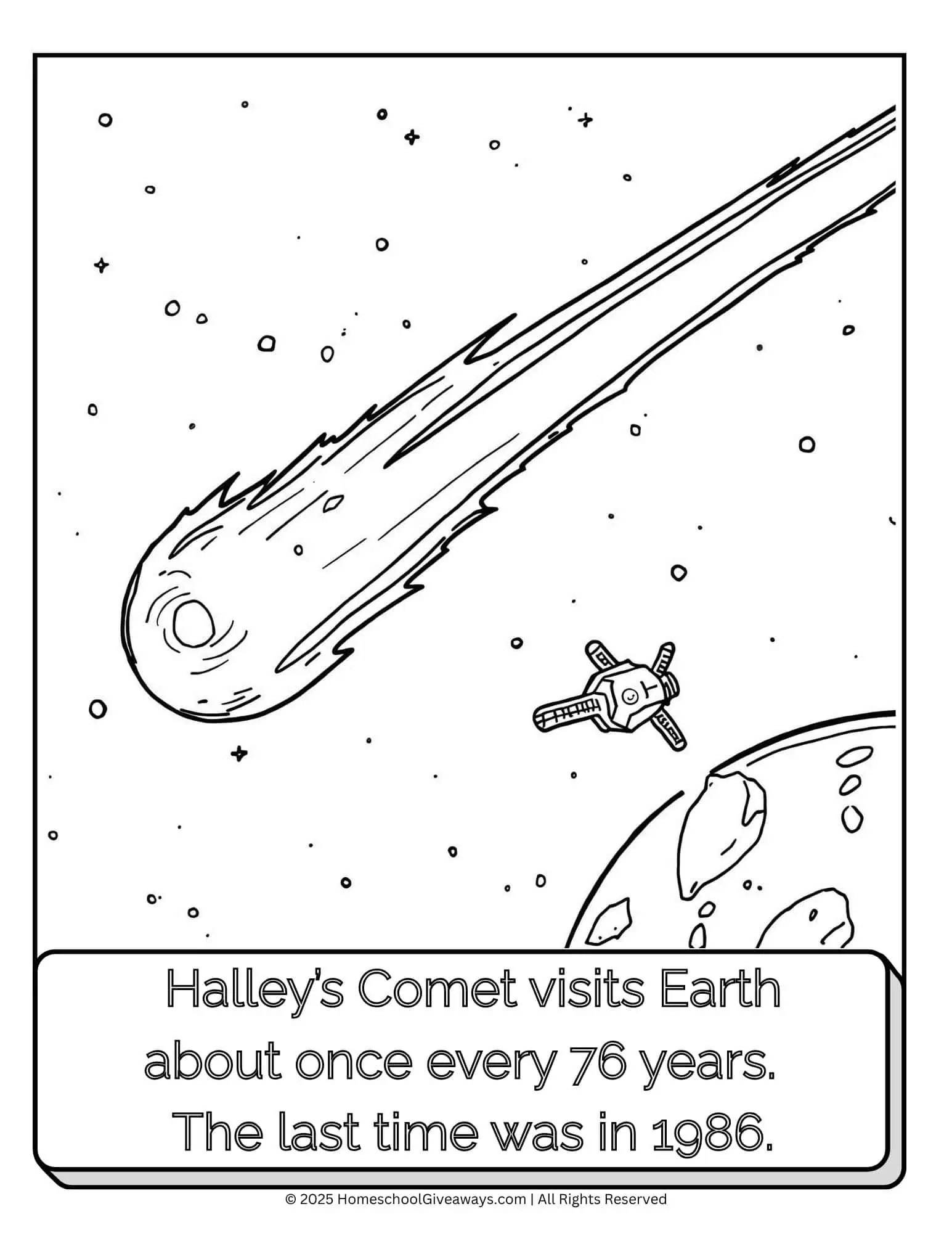
Color your way through space with Halley’s Comet! Did you know this comet swings by Earth only about once every 76 years? The last visit was in 1986-maybe the next time you’ll see it in the sky. Have fun adding color to the comet, stars, planets, and asteroids while learning about this famous visitor.
A supernova is a star bursting with energy-more than the Sun will give off in its whole life. Grab your crayons and color the exploding star, swirling gases, and sparkling stars as you explore this amazing space phenomenon.
Free Planets Cheat Sheets and Fact Cards
Explore key facts about all the planets (including Pluto) with these handy cheat sheets and full-color flash cards. Perfect for reviewing distances, sizes, temperatures, moons, and more, plus black-and-white cards to color or for note-taking.
Test your knowledge of the planets in our solar system with this fun and engaging crossword. A quick activity to get thinking about space before exploring more hands-on learning ideas.
Springboard Learning Ideas (Hands-On & Activities)
Space really comes alive when you do more than read about it. Here are ways to make your homeschool lessons interactive:
- Build a Model Satellite – Create your own satellite using craft supplies or LEGO. For a step-by-step guide, check out this resource.
- Track the ISS – Use NASA’s “Spot the Station” to see when the International Space Station will pass over your area and watch it from outside.
- DIY Solar System – Use balloons, fruit, or clay to model the planets and their distances. Take it outside to stretch out your solar system. For detailed instructions, visit Make a Scale Solar System.
- Museum Field Trips – Visit a local planetarium, museum or space center, such as the National Air and Space Museum in Washington D.C. or the South Dakota Air and Space Museum
- Visit a Space Center: Explore the wonders of space at Space Center Houston, the U.S. Space & Rocket Center in Huntsville, Alabama, or Kennedy Space Center in Florida. Families can see real rockets, astronaut gear, and interactive exhibits.
- Mission X: Train Like an Astronaut – Complete simple astronaut-style exercises like agility courses and balance challenges.
- Make Moon Craters- Drop marbles into flour or cocoa powder to create lunar craters. For a comprehensive guide, refer to Make a Moon Crater – Science Project
- Eclipse in the Living Room – Use a lamp (Sun), a ball (Moon), and a globe (Earth) to model solar and lunar eclipses.
- Space Race Timeline – Research milestones like Laika, Sputnik, and Apollo 11, and build a wall chart timeline.
- Spot Planets with Binoculars – You don’t need a telescope to enjoy planet-watching. Venus, Mars, Jupiter, and Saturn can often be seen with a simple pair of binoculars. Jupiter’s four biggest moons may even be visible as tiny dots. Check NASA’s “What Can You See Tonight?” skywatching guide for the best times to look up.
- Create Space-Themed Snacks – Create edible planets, stars, or rocket ships using fruits, veggies, or cookies-grapes for moons, oranges for planets, and pretzel sticks for rockets. You can also buy fun space-themed treats like astronaut ice cream, Moon Pies, or space rocks on Amazon. Bonus idea: Arrange snacks in order from the Sun to Neptune to practice the planet order while munching.
- Watch Based on True Life Movies – Watch Hidden Figures, October Sky, or NASA documentaries together.
- Celebrate World Space Week (Oct 4-10) – Dedicate each day to a different theme: Moon, famous astronauts, planets, constellations, etc.
Discover the magic of the moon with this fun mini study! Includes worksheets for every moon phase, cut-and-paste matching, shading activities, a colorful phases poster, study cards, flash cards, and even poems. Grab it for purchase in our store, or access it free with your All-Access Document Library pass. Perfect for hands-on learning at home!
Space Books for Kids & Families
Reading is another way to discover even more fun facts about space. Whether you’re cuddling up with a picture book or diving into a detailed space encyclopedia, books can make the universe feel a little closer. Here are some great options for every age level to help your family explore the stars together:
- The Darkest Dark by Chris Hadfield – Picture book by a real astronaut about overcoming fears and dreaming big.
- There’s No Place Like Space! All About our Solar System by Tish Rabe (Cat in the Hat’s Learning Library) – Introduces basic space concepts in a fun, rhyming format.
- Papa, Please Get the Moon for Me by Eric Carle – A gentle story exploring the Moon and imagination.
- The Magic School Bus Lost in the Solar System by Joanna Cole – Ms. Frizzle takes her class on a wild ride through the solar system, making complex space concepts fun and accessible.
- Astronomy for Kids: How to Explore Outer Space with Binoculars, a Telescope, or Just Your Eyes! – by Bruce Betts – Fun facts and hands-on activities for exploring space.
- The Lion of Mars by Jennifer L. Holm – Set on Mars, this novel follows an 11-year-old boy’s life in a Martian colony, exploring themes of community and discovery.
- We Dream of Space by Erin Entrada Kelly – Set in 1986, this Newbery Honor book follows three siblings-Cash, Fitch, and Bird-as they navigate personal challenges while the nation watches the Challenger space shuttle launch.
- Rocket Men: The Daring Odyssey of Apollo 8 and the Astronauts Who Made Man’s First Journey to the Moon by Robert Kurson – True story of early space exploration for older teens.
- Failure Is Not an Option: Mission Control from Mercury to Apollo 13 and Beyond by Gene Kranz – A firsthand account from NASA’s legendary flight director, sharing the behind-the-scenes challenges, teamwork, and problem-solving that kept astronauts safe during the Mercury, Gemini, and Apollo missions.
- The Martian by Andy Weir – Stranded alone on Mars, astronaut Mark Watney must rely on science, ingenuity, and problem-solving to survive. A thrilling and realistic space adventure for older teens interested in engineering, space travel, and perseverance.
Final Thought
From the Kuiper Belt to gamma-ray bursts, from the Great Red Spot to Saturn’s rings, the fun facts about space could feel endless. And while we may never see the Oort Cloud with our own eyes or feel the gravitational pull of a neutron star, learning about the heavens is definitely a great way to inspire curiosity and awe.
Studying space as a family isn’t just about memorizing astronomy terms. It’s about wonder. It’s about looking up at the night sky and remembering how vast creation is, and how much there still is to discover.
So next time your child asks if space is cold, or who the first American in space was, you’ll have the answers as well as and plenty of fun ways to explore together.

